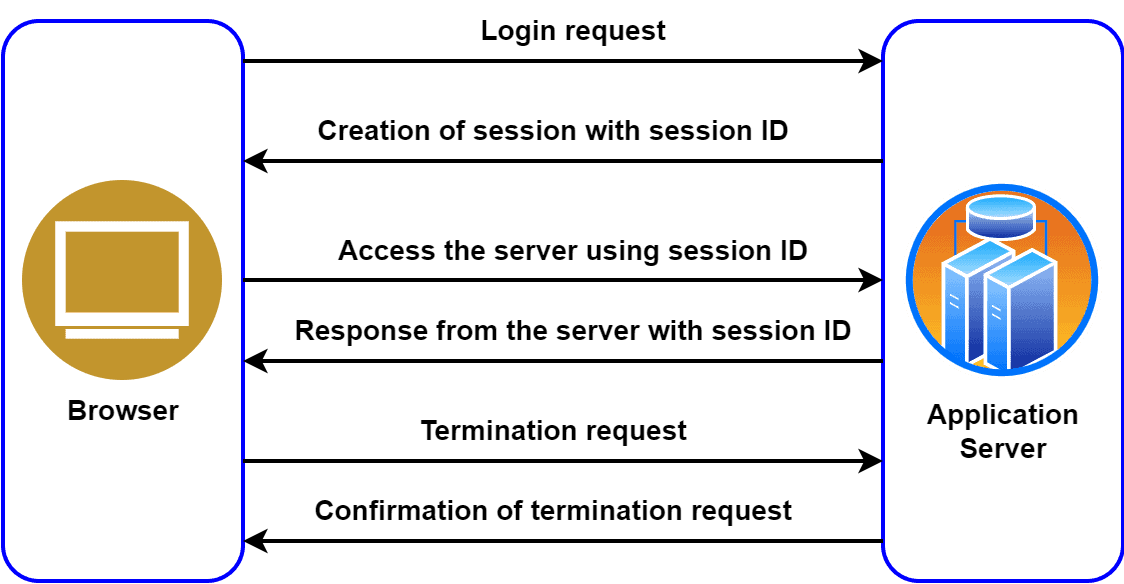1. Overview
In this tutorial, we’ll discuss web sessions. We’ll explore how they work, along with some vital applications.
Finally, we’ll highlight some core advantages and disadvantages of web sessions.
2. Introduction to Session
In the context of web development, a session refers to a way of maintaining state information about a user’s interactions with a website or web application. When a user visits a website, the server can create a session for that user. Additionally, a session allows the server to keep track of information such as the user’s login status, preferences, and any data entered into forms.
The server typically initiates a session when a user logs in to a website. Furthermore, we can identify a session by a unique session ID. Generally, we pass the session IDs as a parameter in URLs or store them in the cookies. The session ID allows the server to associate the user’s requests with their specific session. Additionally, it also helps to retrieve and update the session data as needed.
We can use sessions to provide a personalized experience for each user. We can display a user’s name and preferences throughout the site. Furthermore, a website can use sessions to remember shopping cart contents between pages of a user. Moreover, sessions can also be used to implement security measures and perform certain actions.
3. How Do Web Sessions Work?
A web session is a period of interaction between a user and a website. Furthermore, the website maintains state information about the user’s actions and preferences during a session. The server can initiate a session for a user when they browse through a website. The session remains active until the user logs out. Let’s take a look at how we can start and end a session:

Let’s assume a user wants to access data from an application server. The first step is to log in to the application server from a web browser using secret credentials. As soon the server verifies the credentials and login is successful, it provides a response to the web browser with a unique session ID. The websites generally store the session IDs in cookies.
Furthermore, this unique session ID helps the server keep track of a user’s request for a specific session. Additionally, the server utilizes session IDs to efficiently manage multiple sessions simultaneously.
The browser sends a session termination request as soon as the user finishes accessing data on the server. Therefore, the application server responds to the browser with an acknowledgement and terminates the session.
4. Applications
We can use sessions in various applications. Let’s discuss some crucial applications.
We commonly utilize web sessions to authenticate users on a website or web application. Additionally, a session is created when a user logs in to a site. Furthermore, it allows the user to access restricted content or perform actions only available to authenticated users.
Moreover, we can use web sessions to personalize the user experience on a website. For example, a site might use a session to remember a user’s preferences, such as their language or preferred currency.
Furthermore, we can utilize them in e-commerce sites to manage shopping carts. When a user adds an item to their cart, a session is created that allows the site to keep track of the items in the cart.
Finally, we can track user behavior using sessions. For example, a site might use a session to track which pages a user visits and how long they spend on each page.
Overall, web sessions are a critical component of many web applications and enable a wide range of functionality and user experiences.
5. Advantages and Disadvantages
Let’s see some advantages and disadvantages of web sessions:
Advantages
Disadvantages
Can help to improve the security of a website by allowing the server to authenticate users and prevent unauthorized access to sensitive data
Session hijacking, where an attacker takes over a user’s session and makes changes without their knowledge, is a potential risk
Enables personalized experiences for users, allowing the site to remember user preferences
Increases the load on the server, as the server needs to store and manage session data for each user
Can be used to streamline processes, such as shopping carts and form submissions, by allowing the site to remember user input and carry it over to subsequent pages
Reduces the scalability of a website or web application, as scaling the application requires managing session data across multiple servers
Can be used to track user behavior, providing valuable insights into user interactions with a website or web application
Can raise privacy concerns, as the site may store sensitive user data in session variables
6. Conclusion
In this tutorial, we discussed web sessions. We explored how they work, along with some vital applications. Finally, we highlighted some core advantages and disadvantages of web sessions.